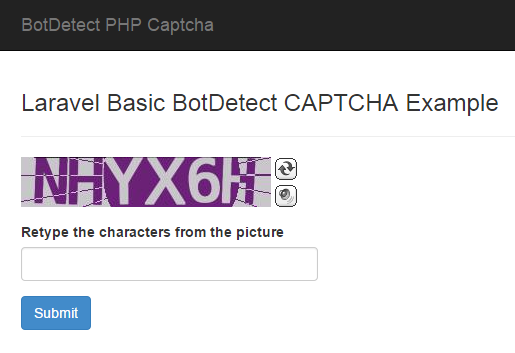Laravel 4.2 Basic BotDetect CAPTCHA Example (BotDetect v3.0; deprecated)
Laravel Basic BotDetect CAPTCHA Example illustrates the most basic form of BotDetect PHP Captcha protection in Laravel MVC applications.
First Time Here?
Check the BotDetect Laravel 4.2 Captcha Quickstart for key integration steps.
Alongside the Captcha image, the user is provided with an input field to retype the displayed characters. Depending on if the Captcha code entered matches the displayed one or not, a message stating the validation result is shown on the form.
The simple code showing the message in this example would of course be replaced with useful form processing code in a real world scenario.

Files for this ('bd-captcha-laravel-4.2-examples') example are:
/app/routes.php/app/views/example.blade.php/app/controllers/ExampleController.php/app/config/captcha_config/ExampleCaptchaConfig.php
The files are available for download as a part of the BotDetect Captcha Laravel integration package.
Routing – /app/routes.php
Route::get('example', 'ExampleController@getExample'); Route::post('example', 'ExampleController@postExample');
In the code above we have registered HTTP GET and POST verbs for the example page. On HTTP GET request to the example page, the getExample() action of the ExampleController is executed, while on a HTTP POST request to the example page, the postExample() action of the ExampleController is executed.
View – /app/views/example.blade.php
<!DOCTYPE html> <html> <head> <meta http-equiv="Content-Type" content="text/html; charset=UTF-8" /> <title>Laravel Basic BotDetect CAPTCHA Example</title> {{ HTML::style('css/bootstrap.min.css') }} <!-- include the BotDetect layout stylesheet --> {{ HTML::style(CaptchaUrls::LayoutStylesheetUrl()) }} <style type="text/css"> body { padding: 70px 0 } .container{ width: 980px !important } </style> </head> <body> <nav class="navbar navbar-inverse navbar-fixed-top" role="navigation"> <div class="container"> <div class="navbar-header"> <a class="navbar-brand" href="#">BotDetect Captcha</a> </div> <div id="navbar" class="navbar-collapse collapse"> <ul class="nav navbar-nav navbar-right"> <li>{{ HTML::link('example', 'Basic Example') }}</li> <li>{{ HTML::link('contact', 'Form Example') }}</li> </ul> </div><!--/.nav-collapse --> </div> </nav> <div class="container"> <h3>Laravel Basic BotDetect CAPTCHA Example</h3><hr> @if (Session::has('status')) <div class="alert alert-success"> {{ Session::get('status') }} </div> @endif @if (count($errors) > 0) <div class="alert alert-danger"> <strong>Whoops!</strong> There were some problems with your input.<br><br> <ul> @foreach ($errors->all() as $error) <li>{{ $error }}</li> @endforeach </ul> </div> @endif {{ Form::open(array('url' => 'example')) }} <div class="form-group"> <!-- show captcha image --> {{ $captchaHtml }} </div> <div class="row"> <div class="form-group col-sm-4"> {{ Form::label('CaptchaCode', 'Retype the characters from the picture') }} <!-- Captcha code user input textbox --> {{ Form::text('CaptchaCode', null, array( 'id' => 'CaptchaCode', 'class' => 'form-control' )) }} </div> </div> {{ Form::submit('Submit', array('class' => 'btn btn-primary')) }} {{ Form::close() }} </div> </body> </html>
The above code uses the Laravel Forms & HTML and the Blade syntax to generate a form, although the actual form can be created in many other ways. The only requirement is that the form contains an input field of your choice where the user can retype the characters shown in the Captcha image. This user-entered code should be available to you in Controller code after form submission.
You should ensure that the form action points to the Controller action of the View to which it belongs to. Also, the name of the input field corresponds to the variable in the request object that we will use for Captcha validation in the Controller.
The Captcha markup made available in the Controller is used in the View to compose a simple form with one input field and a Captcha image. The View utilizes the HTML::style() method to add the required stylesheet, and it also prints out a message about the Captcha validation status (set in the Controller).
Controller – /app/controllers/ExampleController.php
<?php // Importing the BotDetectCaptcha class use LaravelCaptcha\Integration\BotDetectCaptcha; class ExampleController extends BaseController { // get a captcha instance to handle for the example page private function getExampleCaptchaInstance() { // Captcha parameters $captchaConfig = [ 'CaptchaId' => 'ExampleCaptcha', // a unique Id for the Captcha instance 'UserInputId' => 'CaptchaCode', // Id of the Captcha code input textbox // The path of the Captcha config file is inside the config folder 'CaptchaConfigFilePath' => 'captcha_config/ExampleCaptchaConfig.php', ]; return BotDetectCaptcha::GetCaptchaInstance($captchaConfig); } public function getExample() { // captcha instance of the example page $captcha = $this->getExampleCaptchaInstance(); // passing Captcha Html to example view return View::make('example', array('captchaHtml' => $captcha->Html())); } public function postExample() { // captcha instance of the example page $captcha = $this->getExampleCaptchaInstance(); // validate the user-entered Captcha code when the form is submitted $code = Input::get('CaptchaCode'); $isHuman = $captcha->Validate($code); if ($isHuman) { // Captcha validation passed // TODO: continue with form processing, knowing the submission was made by a human return Redirect::to('example') ->with('status', 'CAPTCHA validation passed, human visitor confirmed!'); } // Captcha validation failed, return an error message return Redirect::to('example') ->withErrors(array('CaptchaCode' => 'CAPTCHA validation failed, please try again.')); } }
The example Controller follows the basic instructions from the BotDetect Laravel 4.2 Captcha integration guide.
First, we need to create a function to get an instance of the Captcha class called getExampleCaptchaInstance(), and then the Html required for displaying the Captcha image and integrated controls is made available to the View by pass an array of data as the second parameter to the view helper (or you can also use the with() method).
The example form submits the data to the postExample() action, which is where we check the submitted data and pass it to the Validate() method of the $captcha object.
Captcha configuration options – /app/config/captcha_config/ExampleCaptchaConfig.php
<?php if (!class_exists('CaptchaConfiguration')) { return; } // BotDetect PHP Captcha configuration options $LBD_CaptchaConfig = CaptchaConfiguration::GetSettings(); $LBD_CaptchaConfig->CodeLength = 4; $LBD_CaptchaConfig->ImageWidth = 250; $LBD_CaptchaConfig->ImageHeight = 50;
In the code above, we have overridden the default settings of library. You can find a full list of available Captcha configuration options and related instructions at the Captcha configuration options page.
Please Note
The information on this page is out of date and applies to a deprecated version of BotDetect™ CAPTCHA (v3.0).
An up-to-date equivalent page for the latest BotDetect Captcha release (v4) is BotDetect v4 Captcha documentation index.
General information about the major improvements in the current BotDetect release can be found at the What's New in BotDetect v4.0 page.
Current BotDetect Versions
-
BotDetect ASP.NET CAPTCHA
2019-07-22v4.4.2 -
BotDetect Java CAPTCHA
2019-07-22v4.0.Beta3.7 -
BotDetect PHP CAPTCHA
2019-07-22v4.2.5












